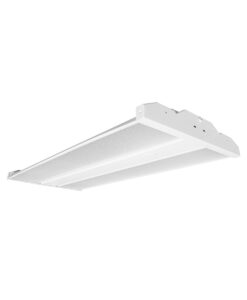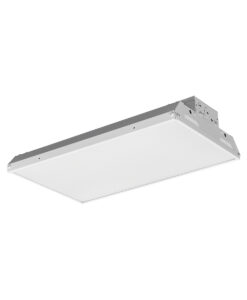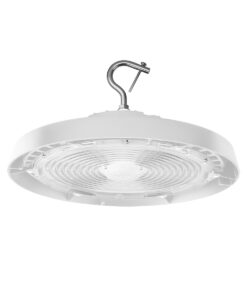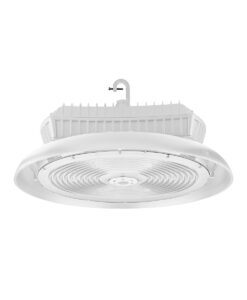At PacLights, we understand the critical role of proper illumination in industrial and commercial spaces. High bay lighting is essential for warehouses, factories, and gymnasiums, where ample overhead clearance demands powerful, well-distributed light.
Mastering high bay light fixture spacing is key to achieving optimal illumination and energy efficiency. This guide will explore the factors influencing fixture placement and provide practical methods for calculating the ideal spacing in your facility.
What Are High Bay Lighting Requirements?
Definition and Purpose of High Bay Lighting
High bay lighting refers to a specialized illumination solution designed for spaces with ceilings typically 20 feet or higher. These powerful fixtures provide intense, uniform light distribution across large areas, making them essential in various industrial and commercial settings.
Common Applications of High Bay Lighting
Warehouses and Distribution Centers
Warehouses and distribution centers depend on high bay lighting for safe navigation and efficient operations. Proper illumination is vital for inventory management, forklift operations, and reading labels on high shelves. General construction areas require a minimum of 5 foot-candles of illumination, and plants and shops require at least 10 foot-candles.
Manufacturing Facilities
Manufacturing facilities benefit greatly from high bay lighting. The bright, consistent illumination helps workers perform intricate tasks with precision, which reduces errors and improves product quality. The Illuminating Engineering Society (IES) suggests that manufacturing areas should maintain light levels between 30 to 100 foot-candles (323 to 1076 lux), depending on the specific tasks performed.
Gymnasiums and Sports Facilities
Gymnasiums and sports facilities require high bay lighting to provide glare-free, uniform illumination for players and spectators. The National Collegiate Athletic Association (NCAA) specifies minimum light levels for various sports, ranging from 50 foot-candles (538 lux) for recreational basketball to 100 foot-candles (1076 lux) for televised events.
The Importance of Proper Spacing
Achieving optimal illumination in high bay environments depends on the correct spacing of light fixtures. Improper spacing can lead to several issues:
- Dark spots and shadows that compromise safety and productivity
- Excessive energy consumption due to overlighting certain areas
- Increased glare, causing visual discomfort and potential safety hazards
- Uneven light distribution, affecting task performance and overall aesthetics

To calculate the ideal distance between high bay lights, you can use a simple formula: Distance (in feet) = Ceiling Height (in feet) ÷ 2. However, this rule of thumb should be adjusted based on specific fixture characteristics and environmental factors.
The next chapter will explore the various factors that influence high bay light fixture spacing, helping you make informed decisions for your lighting design.
What Influences High Bay Light Spacing?
Ceiling Height and Fixture Mounting
The height at which high bay lights are mounted impacts their spacing. Higher mounted fixtures require wider spacing to maintain uniform light distribution. In a warehouse with a 30-foot ceiling, lights might be spaced 20 feet apart. A gymnasium with a 20-foot ceiling may need spacing of 10 to 15 feet.

The Illuminating Engineering Society (IES) recommends mounting heights 15% to 20% lower than the ceiling height. This adjustment prevents glare and ensures proper light distribution, especially in spaces with varying ceiling heights or suspended structures.
Light Output and Beam Angle
Lumen output and beam angle of high bay fixtures affect their coverage area. Higher lumen output allows for wider spacing, while narrower beam angles require closer placement. A 30,000-lumen LED high bay with a 120-degree beam angle might cover a larger area than a 20,000-lumen fixture with a 90-degree beam angle.
Fixtures with adjustable beam angles (such as those offered by PacLights) allow for fine-tuning of light distribution. This flexibility proves valuable in multi-use spaces or areas with changing layout requirements.
Space Dimensions and Obstructions
Room size, shape, and obstacles influence fixture spacing. A rectangular warehouse often benefits from a grid pattern, with fixtures spaced evenly along aisles. L-shaped or irregularly configured spaces require a more customized approach.
The National Electrical Manufacturers Association (NEMA) suggests a distance of at least 1.5 times the mounting height between fixtures and walls. This guideline prevents light loss at the perimeter and ensures consistent illumination throughout the space.
Task-Specific Lighting Needs
Different activities require varying light levels. A packaging area might need 50 foot-candles, while a quality control station could require 100 foot-candles or more. Spacing adjustments accommodate these differences, with closer placement in areas demanding higher light levels.
OSHA provides minimum illumination requirements for various industrial tasks. These standards serve as a starting point for determining appropriate fixture spacing and light levels.
Surface Reflectivity
The reflective properties of walls, floors, and ceilings impact light distribution. Highly reflective surfaces help spread light more effectively, potentially allowing for wider fixture spacing. Dark or non-reflective surfaces may necessitate closer spacing to maintain adequate illumination.
Considering the color and finish of surfaces during the planning stage leads to more accurate spacing calculations and better overall lighting design.
The next chapter will explore practical methods for calculating optimal high bay light spacing, taking into account these influential factors.
How to Calculate Optimal High Bay Light Spacing
The Spacing Criterion Method
The spacing criterion method provides a reliable approach for calculating high bay light fixture placement. This method uses a spacing-to-mounting-height ratio (S/MH) to determine the maximum distance between fixtures while maintaining uniform illumination.

Typically, the S/MH ratio for high bay lights ranges from 1.0 to 1.5. For example, if your mounting height is 30 feet and you use a ratio of 1.2, your maximum spacing would be 36 feet (30 x 1.2 = 36).
This method assumes ideal conditions. In real-world applications, you’ll need to adjust for factors like task-specific lighting requirements and surface reflectivity.
Lighting Design Software
For more complex spaces or when precision is paramount, lighting design software proves invaluable. Programs like DIALux or AGi32 allow you to create detailed 3D models of your space, input fixture specifications, and simulate light distribution.
These tools provide accurate calculations of illuminance levels, uniformity ratios, and glare indices. They also allow you to visualize the lighting layout and make adjustments before installation, potentially saving time and resources.
Many lighting manufacturers offer free lighting layout designs. This service can help if you’re unsure about using design software or need expert input for your specific project.
Quick Estimation Rules
While detailed calculations are ideal, sometimes you need a quick estimate. Here are some rules of thumb for high bay light spacing:
- For general lighting in warehouses, try a spacing of about 1.5 times the mounting height.
- In areas requiring more intense illumination (such as assembly lines), reduce spacing to about 1 times the mounting height.
- For very high ceilings (40+ feet), consider using fixtures with wider beam angles and space them at 1.2 to 1.5 times the mounting height.
These are starting points. Always adjust based on specific fixture characteristics and environmental factors.
It’s better to err on the side of closer spacing. You can always dim lights if needed, but insufficient illumination can lead to safety issues and reduced productivity.
Adjusting for Specific Environments
Different environments require different approaches to high bay light spacing. In warehouses with high shelving, you might need to adjust spacing to ensure adequate illumination between aisles. For manufacturing facilities, consider task-specific lighting needs and adjust spacing accordingly.
In sports facilities, uniform lighting is essential. You might need to reduce spacing to achieve the required light levels for different sports (as specified by organizations like the NCAA).
Considering Energy Efficiency
While calculating optimal spacing, consider the energy efficiency of your lighting solution. LED high bay lights often allow for wider spacing due to their higher lumen output and better light distribution. This can lead to fewer fixtures needed overall, reducing energy consumption and maintenance costs.
You can also create a lighting simulation to calculate how many fixtures are needed for your space. This approach can help you stay updated with the right guidelines for optimal high bay light spacing.
Proper high bay light fixture spacing maximizes visibility, safety, and energy efficiency in large industrial and commercial spaces. Factors such as ceiling height, fixture output, beam angle, room dimensions, task requirements, and surface reflectivity all influence spacing decisions. Complex environments often benefit from professional lighting design, which uses advanced software and expert knowledge to meet specific needs and comply with industry standards.

Optimal spacing of high bay fixtures eliminates dark spots and shadows, reduces accident risks, and improves overall safety. It enhances productivity by providing consistent, glare-free illumination for various tasks. This approach also optimizes energy consumption by avoiding over-lighting and allows for more efficient use of fixtures.
PacLights offers a range of high bay LED fixtures to help you achieve the perfect balance of illumination and energy efficiency. Our custom layout designs and ROI assessments can assist in creating a high bay lighting system that meets current needs and adapts to future changes in your space. You can transform your facility into a well-lit, productive environment that stands the test of time with careful planning and the right fixtures.






Disclaimer: PacLights is not responsible for any actions taken based on the suggestions and information provided in this article, and readers should consult local building and electrical codes for proper guidance.